Unraveling the Sexual Dimorphism of First Instar Nymphs of the Giant Stick Insect, Cladomorphus phyllinus Gray, 1835, from the Atlantic Forest, Brazil
Abstract
:Simple Summary
Abstract
1. Introduction
2. Materials and Methods
3. Results
3.1. Phenotypic Description of the First Instar Nymph
3.1.1. General Aspect
| (±SD) | Median | IQR | p-Value | |||
|---|---|---|---|---|---|---|
| Overall length | Female | 22.2 (0.151) | 22.3 | 0.175 | 4.68 | <0.05 * |
| Male | 22.0 (0.241) | 22 | 0.100 | |||
| Head length | Female | 1.95 (0.053) | 1.95 | 0.100 | 0.192 | 0.661 |
| Male | 1.96 (0.0516) | 2 | 0.100 | |||
| Head width | Female | 2 (0.067) | 2 | 0 | 2.887 | 0.089 |
| Male | 1.95 (0.053) | 1.95 | 0.100 | |||
| Antenna | Female | 13.1 (0.225) | 13.0 | 0.175 | 0.0247 | 0.875 |
| Male | 13.1 (0.212) | 13.0 | 0.200 | |||
| Prothorax length | Female | 1.18 (0.103) | 1.2 | 0.175 | 0 | 1 |
| Male | 0.092 (1.2) | 1.2 | 0.075 | |||
| Mesothorax length | Female | 5.08 (0.123) | 5.05 | 0.175 | 4.263 | <0.05 * |
| Male | 4.91 (0.197) | 5 | 0.075 | |||
| Metathorax length | Female | 4.28 (0.162) | 4.3 | 0.175 | 3.41 | 0.065 |
| Male | 4.15 (0.127) | 4.1 | 0.100 | |||
| Abdomen length | Female | 9.76 (0.158) | 9.8 | 0.25 | 0.472 | 0.492 |
| Male | 9.82 (0.262) | 9.85 | 0.45 | |||
| Fore leg | Female | 15.9 (0.279) | 16 | 0.075 | 12.351 | <0.05 * |
| Male | 15.2 (0.179) | 15.2 | 0.275 | |||
| Middle leg | Female | 13.3 (0.246) | 13.4 | 0.40 | 0.997 | 0.318 |
| Male | 13.2 (0.211) | 13.2 | 0.425 | |||
| Hind leg | Female | 16.6 (0.392) | 16.8 | 0.550 | 4.229 | <0.05 * |
| Male | 16.2 (0.217) | 16.2 | 0.350 | |||
| Mesothoracic suture | Female | 0.99 (0.110) | 1 | 0.075 | 2.839 | 0.092 |
| Male | 1.07 (0.067) | 1 | 0.100 | |||
| Metathoracic suture | Female | 1.07 (0.082) | 1.1 | 0.075 | 3.344 | 0.067 |
| Male | 1.13 (0.048) | 1.1 | 0.075 |
3.1.2. Coloration
3.1.3. Structure and Vestiture
3.2. Sexual Dimorphism in First Instar Nymphs
4. Discussion
5. Conclusions
Author Contributions
Funding
Informed Consent Statement
Data Availability Statement
Acknowledgments
Conflicts of Interest
References
- Andersson, M. Sexual Selection; Princeton University Press: Princeton, NJ, USA, 1994. [Google Scholar]
- Benítez, H.A.; Vidal, M.; Briones, R.; Jerez, V. Sexual Dimorphism and Morphological Variation in Populations of Ceroglossus chilensis (Eschscholtz, 1829) (Coleoptera: Carabidae). J. Entomol. Res. Soc. 2010, 12, 87–95. [Google Scholar]
- Ralls, K.; Mesnick, S. Sexual dimorphism. In Encyclopedia of Marine Mammals, 2nd ed.; Perrin, W.F., Würsig, B., Thewissen, J.G.M., Eds.; Academic Press: London, UK, 2009. [Google Scholar]
- Esperk, T.; Tammaru, T.; Nylin, S.; Teder, T. Achieving high sexual size dimorphism in insects: Females add instars. Ecol. Entomol. 2007, 32, 243–256. [Google Scholar] [CrossRef]
- Blanckenhorn, W.U. Behavioral causes and consequences of sexual size dimorphism. Ethology 2005, 111, 977–1016. [Google Scholar] [CrossRef]
- Daly, H.V. Insect Morphometrics. Ann. Rev Entomol. 1985, 30, 415–438. [Google Scholar] [CrossRef]
- Benítez, H.A.; Sanzana, M.-J.; Jerez, V.; Parra, L.E.; Hernandez, C.E.; Canales-Aguirre, C.B. Sexual Shape and Size Dimorphism in Carabid Beetles of the Genus Ceroglossus: Is Geometric Body Size Similar between Sexes Due to Sex Ratio? Zool. Sci. 2013, 30, 289–295. [Google Scholar] [CrossRef]
- Bradler, S.; Buckley, T.R. Biodiversity of Phasmatodea. In Insect Biodiversity: Science and Society; John Wiley & Sons Ltd.: Hoboken, NJ, USA, 2018; pp. 281–313. [Google Scholar] [CrossRef]
- Simon, S.; Letsch, H.; Bank, S.; Buckley, T.R.; Donath, A.; Liu, S.; Machida, R.; Meusemann, K.; Misof, B.; Podsiadlowski, L.; et al. Old World and New World Phasmatodea: Phylogenomics resolve the evolutionary history of stick and leaf insects. Front. Ecol. Evol. 2019, 7, 345. [Google Scholar] [CrossRef]
- Brock, P.D.; Büsher, T. Stick and Leaf Insects of the World; NAP Editions: Verrières-le-Buisson, France, 2022. [Google Scholar]
- Brock, P.D.; Büscher, T.; Baker, E. Phasmida Species File Online (Version 5.0/5.0). Available online: http://phasmida.speciesfile.org/ (accessed on 5 May 2023).
- Madeira-Ott, T.; Thyssen, P.J.; Costa, J. Phasmatodea (Arthropoda, Insecta) in Brazil: Status, New Record and Proposal for using molecular tools to assist in species identification. Neotrop. Entomol. 2020, 49, 916–922. [Google Scholar] [CrossRef]
- Zompro, O. A key to the stick-insect genera of the ‘Anareolatae’ of the New World, with descriptions of several new taxa (Insecta: Phasmatodea). Stud. Neotrop. Fauna Environ. 2004, 39, 133–144. [Google Scholar] [CrossRef]
- Zompro, O. Phasmatodea. In Insetos do Brasil: Diversidade e Taxonomia; Holos Press: Ribeirão Preto, Brazil, 2012; pp. 289–306. [Google Scholar]
- Araujo, F.F.; Garraffoni, A.R.S. Sinopse dos Phasmatodea (Insecta) Descritos para o Brasil. Entomobrasilis 2012, 5, 232–237. [Google Scholar] [CrossRef]
- Hennemann, F.H.; Conle, O.V.; Perez-Gelabert, D.E. Studies on Neotropical Phasmatodea XVI: Revision of Haplopodini Günther, 1953 (rev. stat.), with notes on the subfamily Cladomorphinae Bradley and Galil, 1977 and the descriptions of a new tribe, four new genera and nine new species (Phasmatodea: “Anareolatae”: Phasmatidae: Cladomorphinae). Zootaxa 2016, 4128, 1–211. [Google Scholar] [CrossRef]
- Heleodoro, R.A.; Queiroz, L.; Rafael, J.A. Two new species of Periphloea Redtenbacher, 1906 (Insecta: Phasmatodea: Pseudophasmatidae) from the Brazilian Amazon Basin. Zootaxa 2021, 5047, 520–530. [Google Scholar] [CrossRef] [PubMed]
- Chiquetto-Machado, P.I.; Morales, E.C.; Cancello, E.M. Taxonomic revision of Paraphasma Redtenbacher, 1906 (Phasmatodea, Pseudophasmatidae) based on phallic and external morphology. Zootaxa 2022, 5122, 1–80. [Google Scholar] [CrossRef] [PubMed]
- Heleodoro, R.A.; Rafael, J.A. Phasmatidae in: Catálogo Taxonômico da Fauna do Brasil. PNUD. Available online: http://fauna.jbrj.gov.br/fauna/faunadobrasil/33855 (accessed on 5 May 2023).
- Lima, A.R.; Kumagai, A.F.; Neto, F.C. Morphological and biological observations on the stick insect Tithonophasma tithonus (Gray, 1835) (Phasmida: Pseudophasmatidae: Pseudophasmatinae). Zootaxa 2013, 3700, 588–592. [Google Scholar] [CrossRef]
- Chiquetto-Machado, P.I. Redescription of the Brazilian stick insect Pseudophasma cambridgei Kirby (Phasmatodea: Pseudophasmatidae), with first description of the female and egg. Austral Entomol. 2018, 57, 392–402. [Google Scholar] [CrossRef]
- Kumagai, A.F.; Fonseca, N.G. Uma nova espécie de Cladomorphus (Phasmatidae, Cladomorphinae) de Minas Gerais, Brasil. Rev. Bras. Entomol. 2009, 53, 41–44. [Google Scholar] [CrossRef]
- Costa, J.; Mallet, J.R.S.; Takiya, D.M. Cladomorphus petropolisensis, a New Species of Stick Insect from the Atlantic Forest, Rio de Janeiro, Brazil. Animals 2022, 12, 2871. [Google Scholar] [CrossRef] [PubMed]
- Heleodoro, R.A. The first two cases of antisymmetry in the male genitalia of Phasmatodea reveal a new species of Isagoras Stål, 1875 (Phasmatodea: Pseudophasmatidae: Xerosomatinae) from the Brazilian Atlantic Forest. Zool. Anz. 2022, 296, 161–178. [Google Scholar] [CrossRef]
- Clark, J.T. The eggs of stick insects (Phasmida): A review with descriptions of the eggs of eleven species. Syst. Entomol. 1976, 1, 95–105. [Google Scholar] [CrossRef]
- Clark, J.T. A key to the eggs of stick and leaf insects (Phasmida). Syst. Entomol. 1979, 4, 325–331. [Google Scholar] [CrossRef]
- Sellick, J. The range of egg capsule morphology within the Phasmatodea and its relevance to the taxonomy of the order. Ital. J. Zool. 1997, 64, 97–104. [Google Scholar] [CrossRef]
- Goldberg, J.; Bresseel, C.J.; Kneubühler, B.; Leubner, F.; Michalik, P.; Bradler, S. Extreme convergence in egg-laying strategy across insect orders. Sci. Rep. 2015, 5, 7825. [Google Scholar] [CrossRef] [PubMed]
- Chiquetto-Machado, P.I.; Albertoni, F.F. Description of the female, egg and first instar nymph of the stick insect Paraphasma paulense (Phasmatodea: Pseudophasmatidae) from Southeast Brazil. J. Orthoptera Res. 2017, 26, 91–101. [Google Scholar] [CrossRef]
- Bradler, S. Die Phylogenie der Stab- und Gespenstschrecken (Insecta: Phasmatodea). In Species, Phylogeny and Evolution; Georg-August-Universität: Göttingen, German, 2009; pp. 3–139. [Google Scholar]
- Bank, S.; Bradler, S.A. second view on the evolution of flight in stick and leaf insects (Phasmatodea). BMC Ecol. Evo. 2022, 22, 2–17. [Google Scholar] [CrossRef] [PubMed]
- Dorval, A.; Peres-Filho, O.; Moraes, C.S.P.; Berti-Filho, E. Biologia e Estudo Comportamental de Bacteria tuberculata Piza Jr. 1939 (Phasmatodea; Phasmatidae) em Folhas de Anjico (Piptenia spp.). Sci. For. 2003, 63, 150–157. Available online: http://www.ipef.br/publicacoes/scientia/nr63/cap12.pdf (accessed on 4 May 2022).
- Alvarenga, C.D.; Souza, H.R.; Giustolin, T.A.; Matrangolo, C.A.R.; Silva, J.F. Biologia de Cladomorphus phyllinus Gray (Phasmatodea: Phasmatidae) em folhas de goiabeira (Psidium guajava). EntomoBrasilis 2018, 11, 65–69. [Google Scholar] [CrossRef]
- Costa, J.; Torres, L.; Provance, W.D.; Brugnera, R.; Grazia, J. First report of predation by a stink bug (Supputius cincticeps Stål) on a walking-stick insect (Cladomorphus phyllinus Gray), with reflections on evolutionary mechanisms for camouflage. Paraná Acta Biol. 2019, 48, 5–15. [Google Scholar]
- Costa, J.; Chiquetto-Machado, P.I.; Gil-Santana, H. Predation strategies of Harpactor angulosus (Lepeletier & Serville, 1825) (Hemiptera: Reduviidae) on Cladomorphus phyllinus Gray, 1835 (Phasmatodea: Phasmatidae) in captivity. Rev. Chilena Ent. 2022, 48, 531–543. [Google Scholar] [CrossRef]
- Torres, L.; Benitez, H.A.; Costa, J. Longevity, fertility and average eggs viability of parthenogenetic females of Cladomorphus phyllinus Gray (Phasmatodea, Phasmatide). Entomobrasilis 2022, 15, 998. [Google Scholar] [CrossRef]
- Torres, L.; Costa, J. Eu, Bicho-Pau; Fiocruz: Rio de Janeiro, Brasil, 2020; pp. 1–23. ISBN 978-65-00-21891-6. Available online: https://portal.fiocruz.br/noticia/fiocruz-lanca-livro-sobre-biodiversidade-para-criancas (accessed on 15 June 2023).
- Costa-Lima, A.M. Insetos do Brasil; Série didática; Escola Nacional de Agronomia: Rio de Janeiro, Brazil, 1938; pp. 2–453. [Google Scholar]
- Leuzinger, H.; Wiesmann, R.M.; Lehmann, F.E. Zur Kenntnis der Anatomie und Entwicklungsgeschichte der Stabheuschrecke Carausius Morosus; Gustav Fischer: Jena, Germany, 1926. [Google Scholar]
- Wilbert, H. Normales und experimentell beeinflusstes Auftreten von Männchen und Gynandromorphen der Stabheuschrecke. Zool. Jahrb. Physiol. 1953, 64, 470–495. [Google Scholar]
- Dürr, V.; Mesanovic, A. Behavioural function and development of body-to-limb proportions and active movement ranges in three stick insect species. J. Comp. Physiol. 2023, 209, 265–284. [Google Scholar] [CrossRef]
- Djordjevic, J.; Dumas, Z.; Robinson-Rechavi, M.; Schwander, T.; Parker, D.J. Dynamics of sex-biased gene expression during development in the stick insect Timema Californicum. Hered. 2022, 129, 113–122. [Google Scholar] [CrossRef]
- Badyaev, A.V.; Whittingham, L.A.; Hill, G.E. The evolution of sexual size dimorphism in house finch. III. Developmental basis. Evolution 2001, 55, 176–189. [Google Scholar]
- Badyaev, A.V. Growing apart: An ontogenetic perspective on the evolution of sexual size dimorphism. Trends Ecol. Evolut. 2002, 17, 369–378. [Google Scholar] [CrossRef]
- Langer, L.; Froschauer, C.; Reinhardt, K. Sex differences in bedbug nymphs, Cimex lectularius. J. Appl. Entomol. 2020, 144, 838–843. [Google Scholar] [CrossRef]
- Goncalves, T.C.M.; Jurberg, J.; Costa, J.M.; Souza, W. Estudo morfológico comparativo de ovos e ninfas de Triatoma maculata (Erichson, 1848) e Triatoma pseudomaculata Correa & Espínola, 1964 (Hemiptera, Reduviidae, Triatominae). Mem. Inst. Oswaldo Cruz. 1985, 80, 263–276. [Google Scholar]
- Jurberg, J.; Gonçalves, T.C.M.; Costa, J.M.; Souza, W. Contribuição ao estudo morfológico de ovos e ninfas de Triatoma brasiliensis Neiva, 1911 (Hemiptera, Reduviidae, Triatominae). Mem. Inst. Oswaldo Cruz. 1986, 81, 111–120. [Google Scholar] [CrossRef]
- Cook, L.G.; Gullan, P.J.; Stewart, A.C. First-instar morphology and sexual dimorphism in the gall-inducing scale insect Apiomorpha Rubsaamen (Hemiptera: Coccoidea: Eriococcidae). J. Nat. Hist. 2000, 34, 879–894. [Google Scholar] [CrossRef]
- Whiting, M.F.; Bradler, S.; Maxwell, T. Loss and recovery of wings in stick insects. Nature 2003, 421, 264–267. [Google Scholar] [CrossRef]
- Zeng, Y.; O’Malley, C.; Singhal, S.; Rahim, F.; Park, S.; Chen, X.; Dudley, R. A tale of winglets: Evolution of flight morphology in stick insects. Front. Ecol. Evol. 2020, 8, 1–121. [Google Scholar] [CrossRef]
- Brock, P.D.; Hasenpusch, J. Studies on the Australian stick insects (Phasmida), including a checklist of species and bibliography. In Zootaxa; Magnolia Press: Auckland, New Zealand, 2007; pp. 1–81. [Google Scholar]
- Brock, P.D. Studies on the Australasian stick-insect genus Extatosoma Gray (Phasmida: Phasmatidae: Tropoderinae: Extatosomatini). J. Orthoptera Res. 2001, 10, 303–313. [Google Scholar] [CrossRef]
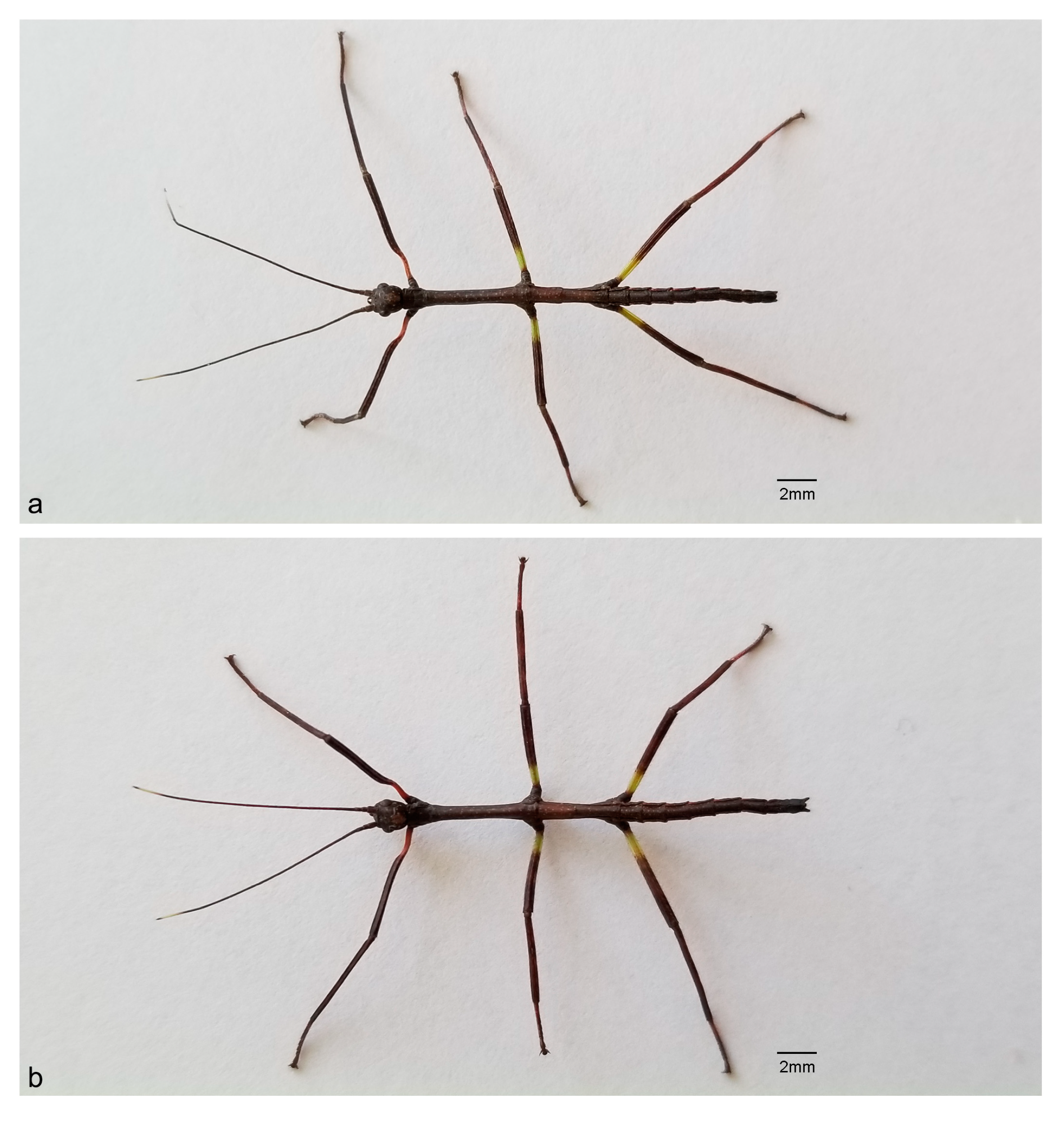
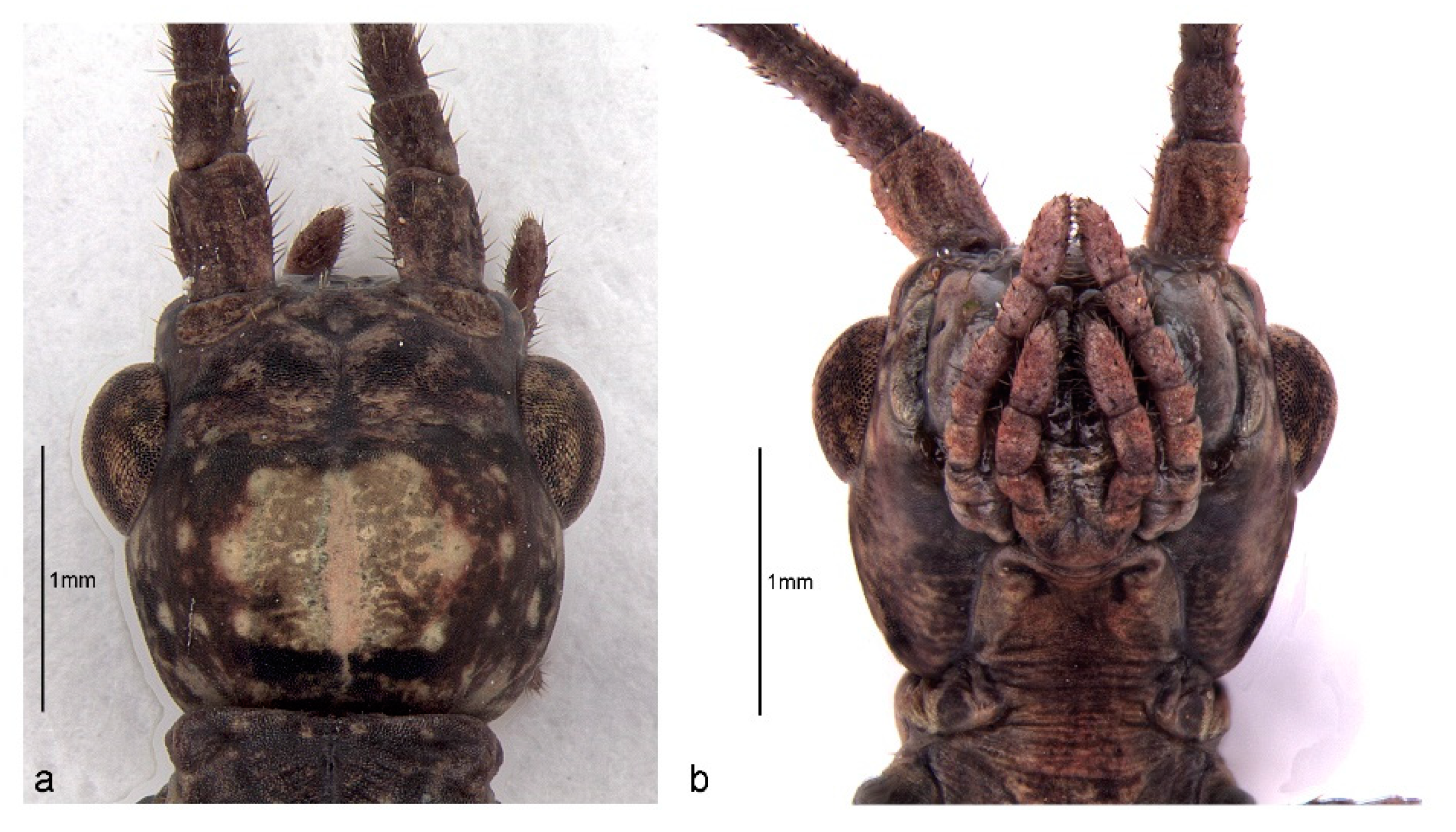
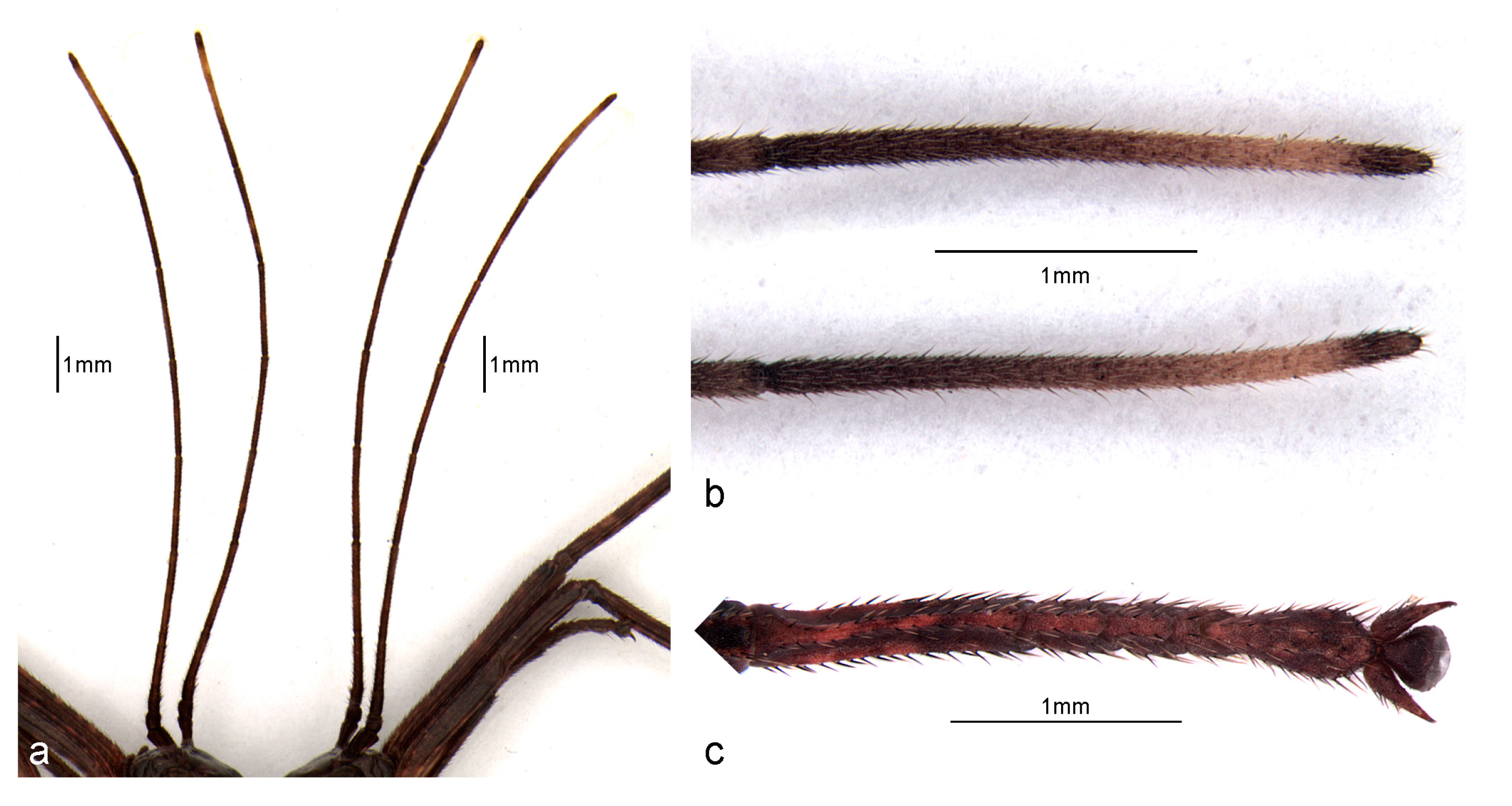
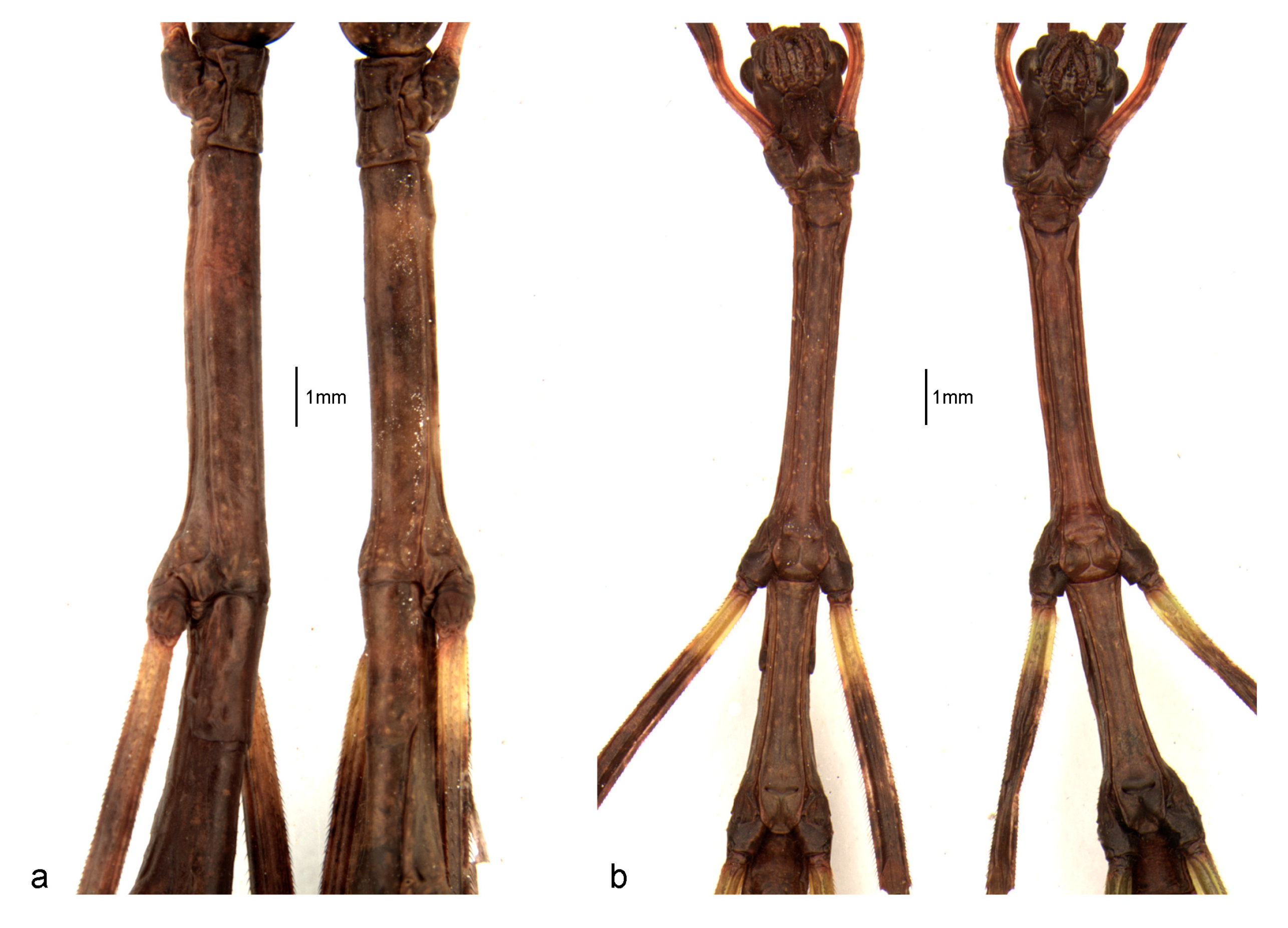


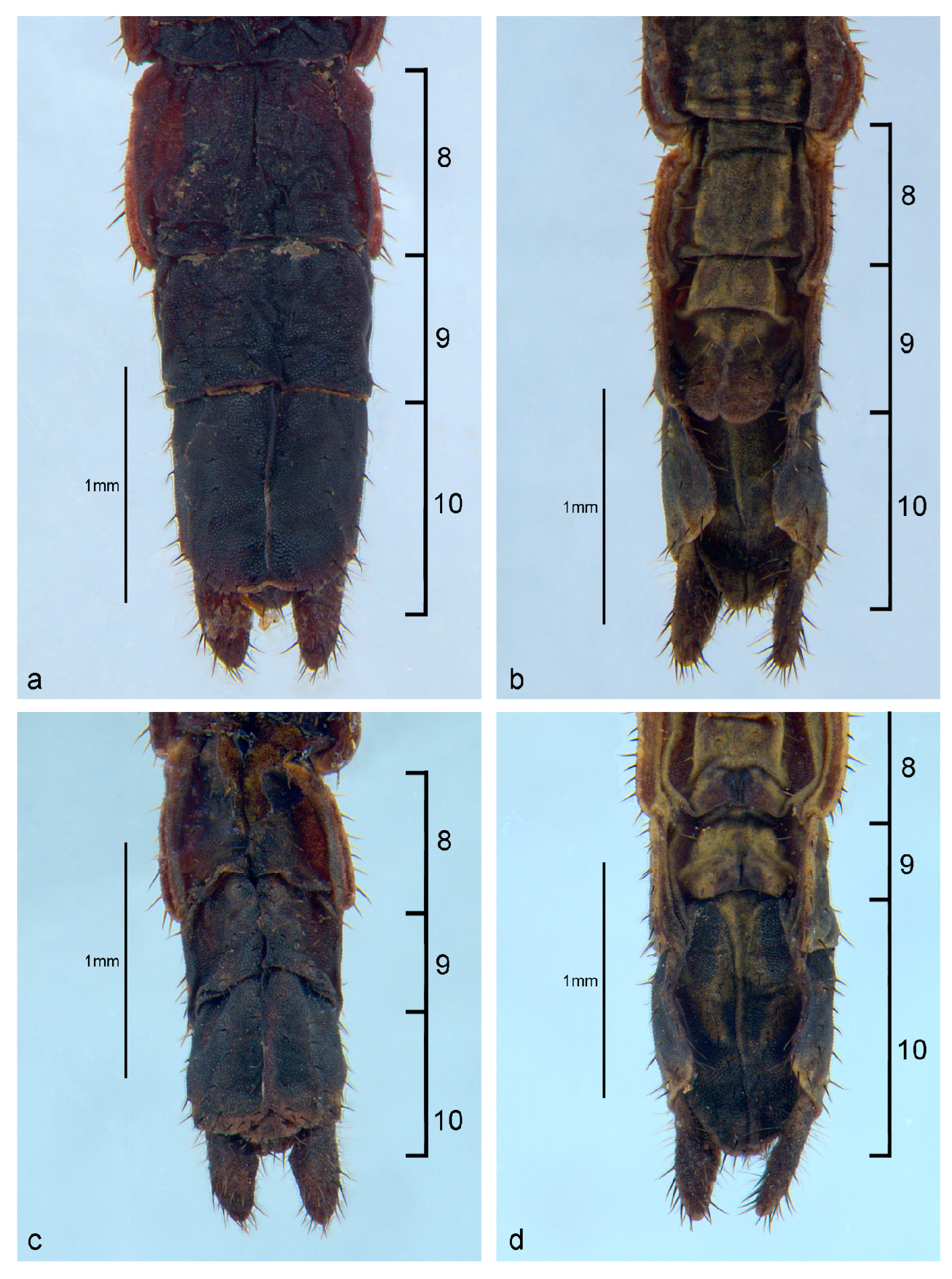

Disclaimer/Publisher’s Note: The statements, opinions and data contained in all publications are solely those of the individual author(s) and contributor(s) and not of MDPI and/or the editor(s). MDPI and/or the editor(s) disclaim responsibility for any injury to people or property resulting from any ideas, methods, instructions or products referred to in the content. |
© 2023 by the authors. Licensee MDPI, Basel, Switzerland. This article is an open access article distributed under the terms and conditions of the Creative Commons Attribution (CC BY) license (https://creativecommons.org/licenses/by/4.0/).
Share and Cite
Costa, J.; Torres, L.; Paschoaletto, L.; Pimenta, A.L.A.; Benítez, H.A.; Suazo, M.J.; Reigada, C.; Gil-Santana, H.R. Unraveling the Sexual Dimorphism of First Instar Nymphs of the Giant Stick Insect, Cladomorphus phyllinus Gray, 1835, from the Atlantic Forest, Brazil. Animals 2023, 13, 3474. https://doi.org/10.3390/ani13223474
Costa J, Torres L, Paschoaletto L, Pimenta ALA, Benítez HA, Suazo MJ, Reigada C, Gil-Santana HR. Unraveling the Sexual Dimorphism of First Instar Nymphs of the Giant Stick Insect, Cladomorphus phyllinus Gray, 1835, from the Atlantic Forest, Brazil. Animals. 2023; 13(22):3474. https://doi.org/10.3390/ani13223474
Chicago/Turabian StyleCosta, Jane, Lucas Torres, Leticia Paschoaletto, Ana Luiza Anes Pimenta, Hugo A. Benítez, Manuel J. Suazo, Carolina Reigada, and Hélcio R. Gil-Santana. 2023. "Unraveling the Sexual Dimorphism of First Instar Nymphs of the Giant Stick Insect, Cladomorphus phyllinus Gray, 1835, from the Atlantic Forest, Brazil" Animals 13, no. 22: 3474. https://doi.org/10.3390/ani13223474
APA StyleCosta, J., Torres, L., Paschoaletto, L., Pimenta, A. L. A., Benítez, H. A., Suazo, M. J., Reigada, C., & Gil-Santana, H. R. (2023). Unraveling the Sexual Dimorphism of First Instar Nymphs of the Giant Stick Insect, Cladomorphus phyllinus Gray, 1835, from the Atlantic Forest, Brazil. Animals, 13(22), 3474. https://doi.org/10.3390/ani13223474









